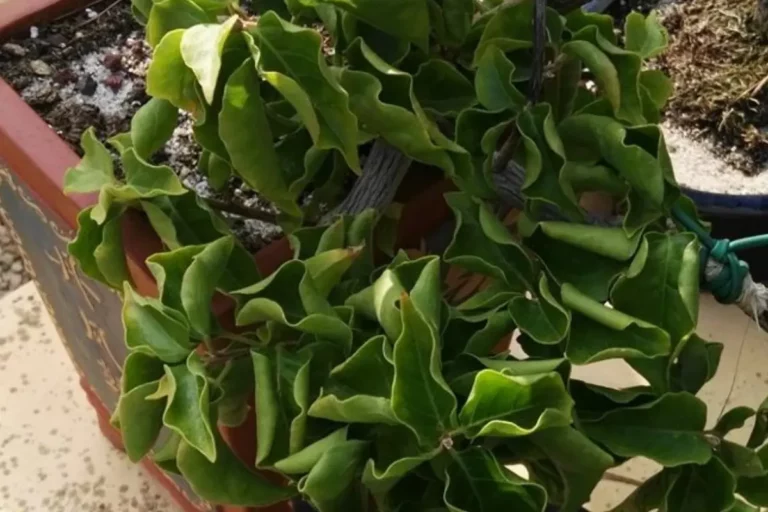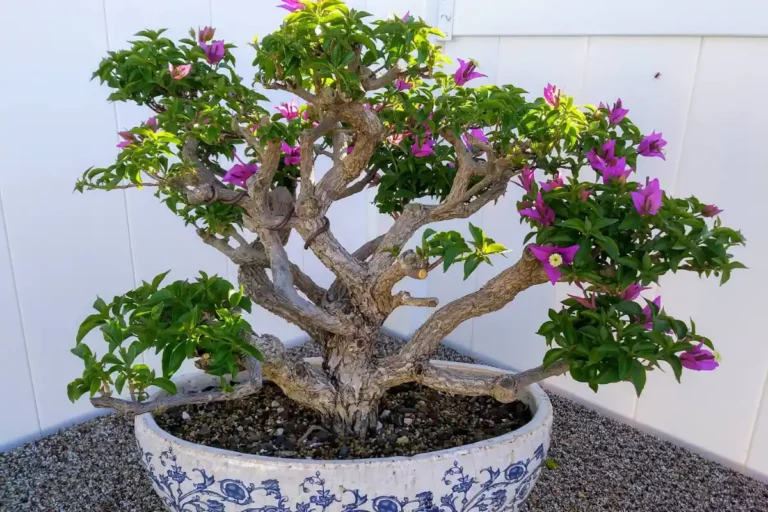Bougainvillea Care – Water, Light, Soil + Winter Tips
Bougainvillea is a beautiful flowering plant that is native to South America. It is known for its colorful bracts, the structures surrounding the flowers. The plant is relatively easy to care for indoors in pots and outdoors, but it has some specific requirements.
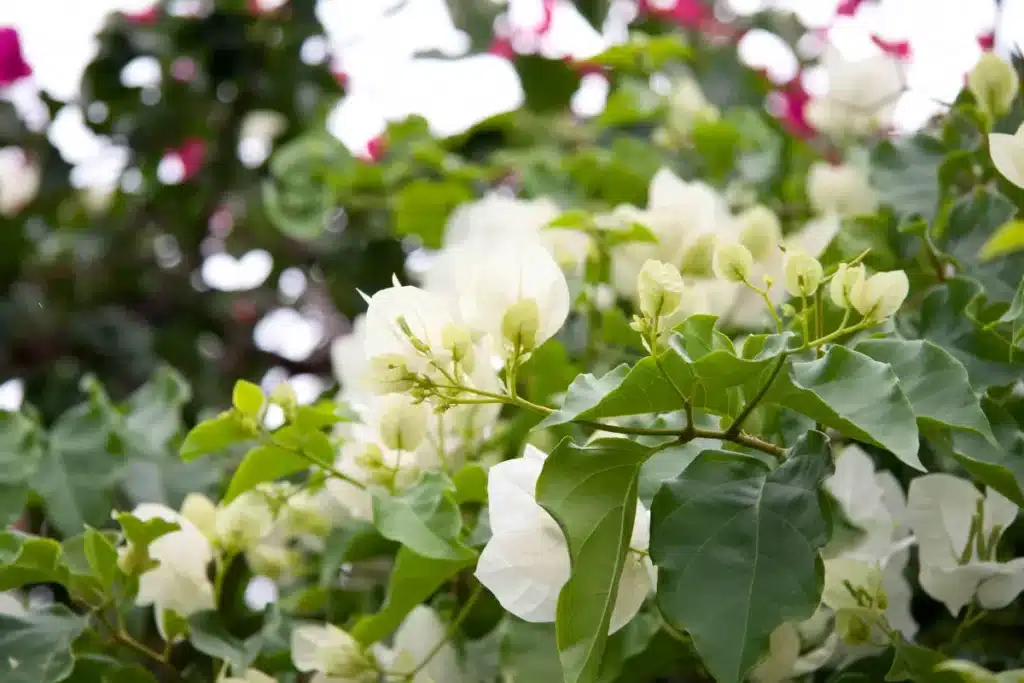
We grow bougainvillea as potted plants in our nurseries, but we also tend to some grown outdoors in pots. In this article, I’ll discuss the basic care requirements for Bougainvillea, including sunlight, water, soil, fertilizer, and pruning.
Contents:
Overview
Bougainvillea is a colorful vine native to tropical South America and was named after Louis Antoine de Bougainville, the commander of a French expedition that circumnavigated the globe in 1766-69. This genus belongs to the Nyctaginaceae family of plants.
Here’s the taxonomy of bougainvillea:[1]
- Division: Magnoliophyta (Flowering plants)
- Class: Magnoliopsida (Dicotyledons)
- Subclass: Caryophyllidae
- Order: Caryophyllales
- Family: Nyctaginaceae
- Genus: Bougainvillea
Some common varieties of Bougainvillea include the great bougainvillea (Bougainvillea spectabilis), Barbara Karst, Orange King, Imperial Delight, Miss Alice, Helen Johnson, and Pink Pixie.
Some of these species are dwarf while others exist as standard-sized vines. You can also grow bougainvillea as a bonsai tree.
| Names | Bougainvillea |
| Sunlight | Bright, direct sunlight |
| Water | Once every 3-4 weeks |
| Temperature | 60 to 70 degrees Fahrenheit |
| Humidity | At least 50% relative humidity |
| Soil pH | 5-6.5 pH |
| Size | 40 feet tall and 10 feet wide. |
| USDA Zones | Zones 9, 10, and 11 |
Care requirements for bougainvillea
Here’s how to grow bougainvillea successfully:
Sunlight
Bougainvillea plants prefer to grow in full sun. They like as much sun as they can get. For prolific blooming, these plants should get at least six hours of full sunlight daily.

Bougainvillea plants growing in dark or shaded conditions receiving less than 6 hours of sun per day is likely to grow thin and leggy with a reduced bloom rate.
If your plant shows these symptoms, it likely isn’t getting at least 6 hours of direct sunlight daily.
Move it from the dark or shaded conditions and place it in a spot that experiences the full brightness of the sun, preferably in the morning. The plant will reward you with a riot of colorful blooms.
Water requirements
Bougainvillea prefers a good, deep watering every three or four weeks. Frequent shallow waterings can lead to root rot. Due to its decent drought tolerance, the plant prefers to be on the dry side.
If you live in a hot, dry climate, you may need to water more often. However, avoid overwatering, as this can lead to root rot.
To test whether your bougainvillea needs water, check the top inch of the soil using your finger or a stick.
Young bougainvillea plants have a higher appetite for water and should be watered regularly to promote root establishment. When starting the plants, I prefer irrigating them once per week during summer and at least twice weekly when temperatures exceed 100 degrees Fahrenheit. This helps them establish healthy roots.
Remember, it takes up to two years for bougainvillea to be fully established.
Soil for bougainvillea
Bougainvillea prefers gritty, fast-draining, loose soil. Compact, waterlogged soils put the plant at risk of root rot. If the soil is compact or drains slowly, adding perlite, sand, or vermiculite is recommended to improve drainage.
Use at least 4 inches of soil when growing bougainvillea in a pot. Excess soil retains too much moisture, creating a conducive environment for fungi to grow.
Bougainvillea grows best in slightly acidic soil with 5.5-6.5 pH. You’ll need to lower or increase acidity if you have a highly acidic or alkaline soil mix.
Gardeners tip:
A good trick that works for me is adding ground limestone or baking soda to raise the soil pH from highly acidic to mildly acidic. Adding dilute sulfuric acid or elemental sulfur can also help lower soil pH and make it slightly acidic, which is ideal for bougainvillea.
Humidity
Bougainvillea loves humid conditions, especially during the growing season. The relative humidity around the plant should be at least 50%.
You can use a humidity monitor to keep track of the relative humidity around your indoor bougainvillea tree.
During heat waves, humidity levels can drop significantly, which can stress the plant and lead to wilting, leaf drop, and other problems. To meet your potted bougainvillea’s humidity requirements, I recommend moving it to a shady spot, misting it regularly with a spray bottle, or placing a humidifier near it.
Temperature
Bougainvillea is classified as cold-hardy in USDA plant hardiness zones 9b, 10, and 11.[2] These zones only experience light winter frost, and winter temperatures don’t drop below 65 degrees Fahrenheit at night.
The plant can suffer serious damage if temperatures drop below 32 degrees Fahrenheit. Leaves will fall off, and new ones only appear in the following spring.
Note: Mature bougainvillea trees are more frost-hardy than younger ones that aren’t yet fully established.
Fertilizer
Potted bougainvillea should be fed fertilizer every two weeks to encourage growth and flowering during the growing season. However, avoid using nitrogen-heavy fertilizer, as nitrogen encourages the production of more leaves at the expense of more flowers.
The best choices include water-soluble fertilizer, slow-release nitrogen fertilizer, and compost.
The most suitable fertilizers for bougainvillea have an NPK (nitrogen- phosphorus- potassium) ratio of 1:1:1 or 2:1:2.
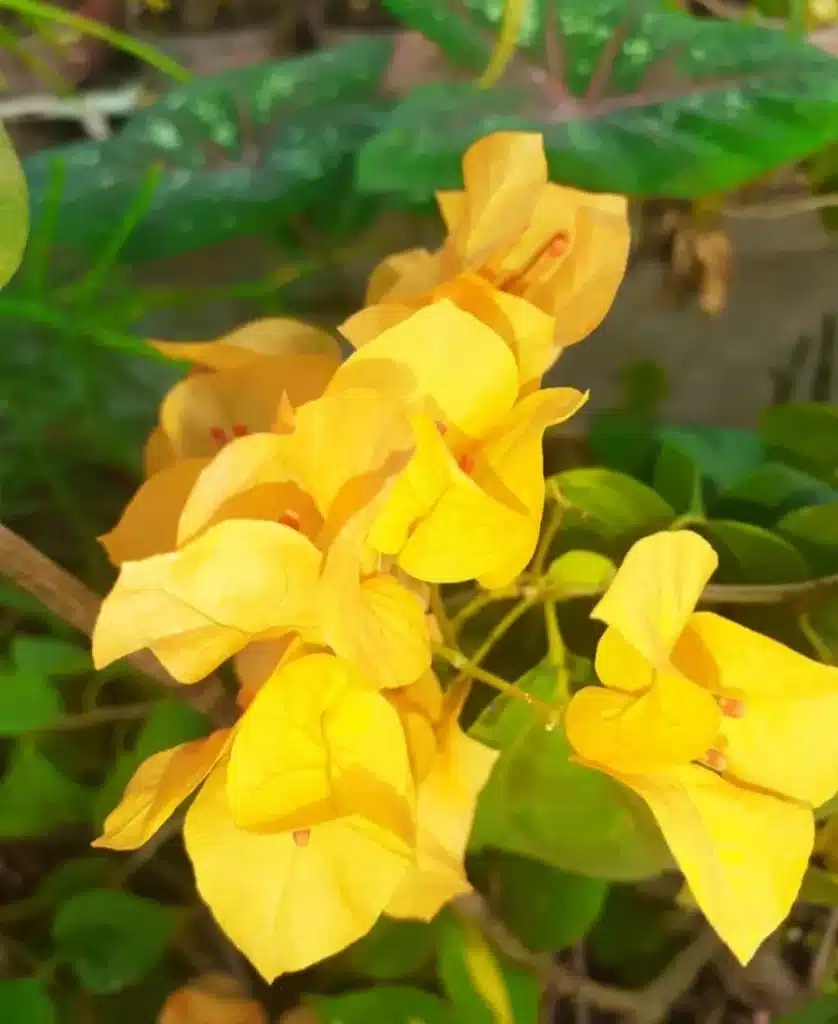
After fertilizing your bougainvillea, we recommend watering it well to help the fertilizer dissolve and be absorbed by the roots.
You should then water the plant every other day for the next week, checking the soil moisture each time. If the soil is still too wet, you can skip a day of watering.
Potting and repotting
If you live in a region with frigid winters but still wish to grow bougainvillea, you can grow it as a potted plant indoors. Select a short, shrubby bougainvillea that can be grown inside a pot, unlike the climbing types with heavier limbs.
Low-growing bougainvillea species include La Jolla, Vera Deep Purple, and Crimson Jewel.
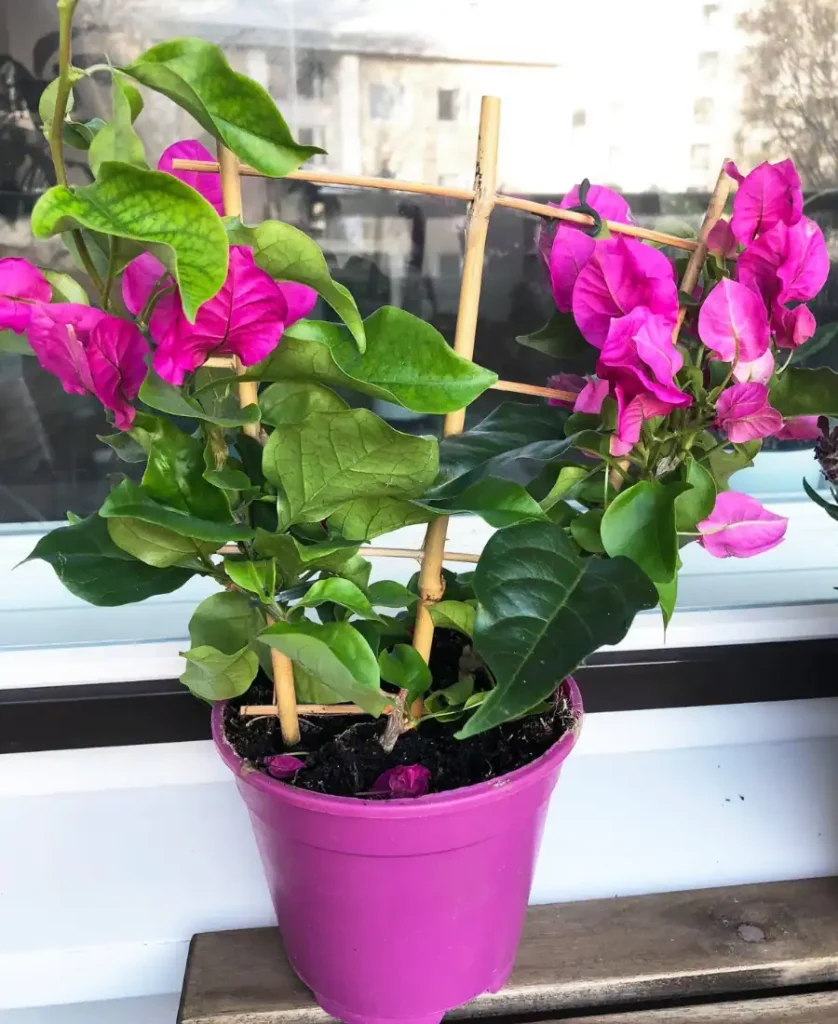
As opposed to many other ornamentals, bougainvillea blooms more prolific when the plant is root-bound. Crowding the plant’s roots inside a container produces a showier accent plant.
Keep bougainvillea close to a sunny window during winter for added warmth.
The ideal potting mix for bougainvillea should be rich and well-draining. The perfect blend is 3/4 good quality potting soil, 1/4 compost, and a dash of succulent soil mix. Avoid soil mixes containing peat moss. Peat moss retains water and can stress the plant.
Here are a few more tips when growing bougainvillea as a potted plant.
- Ensure the growing container has drainage holes to prevent root rot due to saturated soil conditions.
- Ensure the entire bougainvillea root ball is under the soil surface, and lightly pat down the soil after planting for a firm hold.
- Bougainvillea prefers deep, infrequent watering. Therefore, drench the soil until you see water coming out of the drainage holes to guarantee proper watering.
- Bougainvillea is a fast-growing ornamental, especially the climbing varieties. Regular repotting is necessary so that the plant doesn’t outgrow its container.
Here’s a quick how-to on repotting bougainvillea:
- Remove it from the old pot. Grab the base of the stem, tilt the pot to the side, and pull out with the pot in this sideways position.
- Fill the new container with three inches of a cactus potting soil mix.
- Place the bougainvillea inside the pot, ensuring the whole root ball is covered in soil.
- Water the repotted plant to boost root establishment in the new soil mix.
When to prune
If you wish to grow bougainvillea as bonsai or a hedge, you can prune it into a shrub-like structure. Pruning is also used to train the plant to grow over walls when going for an artificial or natural fence.
The best time of the year to prune bougainvillea is at the end of winter or early spring after the blooming period has passed. Avoid pruning in late summer or fall. It would yield less prolific blooms the following winter. Pruning at the end of the blooming season also promotes healthy growth the following spring.
When pruning your bougainvillea into a desirable shrub-like shape, use a pair of sterilized pruning shears to avoid spreading diseases. Also, ensure you wear heavy-duty gloves for protection against thorny bougainvillea cultivars.
According to William Gonzalez, a landscaping expert from Boynton Beach, Florida, “Knowing when and how to prune bougainvillea will determine if you’re growing it as a bush or on a trellis.”
He goes on to explain, “Bougainvillea is a versatile plant that can be used in a variety of ways. We often grow it as a privacy screen, as its strong vine-like habit allows it to quickly cover large areas.
It can also be used as a patio or balcony plant, where its colorful flowers will add a touch of beauty to any space. In all this, the style of pruning bougainvillea is very important.”
Note: You can also prune off bougainvillea limbs and use them to propagate new bougainvillea plants.
Winter care
Being a tropical plant, bougainvillea doesn’t like cold climates. Cold winters can kill the plant if it is not protected or well-cared for. As soon as winter kicks in, you want to change your watering, fertilizer, and pruning routines.
Here are the adjustments you need to make in winter:
- Watering during winter: Water bougainvillea less often in winter, preferably once every 4-6 weeks to prevent the soil from drying out completely. I recommend light watering, as drenching the soil will lead to fungal diseases such as root rot.
- Fertilizer in winter: Do not fertilize bougainvillea in winter because the plant isn’t actively growing. Applying fertilizer can burn and kill your bougainvillea rather than nourish it.
- Pruning: Prune bougainvillea after the risk of frost is over, in early spring. Remember, different people prune the plant for different purposes. For example, you can cut it back to help shape it or encourage new growth.
- Shelter: If you live in a cold climate, you may need to bring your potted bougainvillea indoors when temperatures drop below 32 degrees F. Protecting the plant from the cold by wrapping the pot in burlap or bubble wrap is also recommended.
During the cold season, bougainvillea may lose some or all of its leaves. Do not worry if this happens; the leaves will come back in spring.
Once spring arrives, help the plant transition back to outdoor conditions by gradually increasing its sunlight exposure.
Blooms

Bougainvillea flowers are typically small and white. They’re surrounded by colorful bracts, which determine the color of the blooms.
Blooms come in a variety of colors. Pink is the most common color, with shades ranging from light pink to deep rose. Other colors include magenta, purple, red, orange, yellow, and white.
In addition to these basic colors, some hybrid bougainvillea varieties produce bicolor and tricolor varieties.
Bicolor bougainvillea blooms have two colors, such as pink and white or magenta and yellow. Tricolor bougainvillea blooms have three colors, such as pink, magenta, and orange.
In warmer climates, bougainvillea bloom on and off all year round, but in colder climates, expect flowers only in the warmer summer months.
The color intensity of bougainvillea blooms is often determined by the amount of sunlight the plant receives. Bougainvillea blooms that receive more sunlight are generally brighter in color than those growing in shade or partial shade.
Mature size
Bougainvillea is a climbing plant whose vines can grow up to 40 feet tall with proper support. However, this genus of plants contains at least 16 species, with some of the varieties being low-growers typically grown as hedge shrubs.
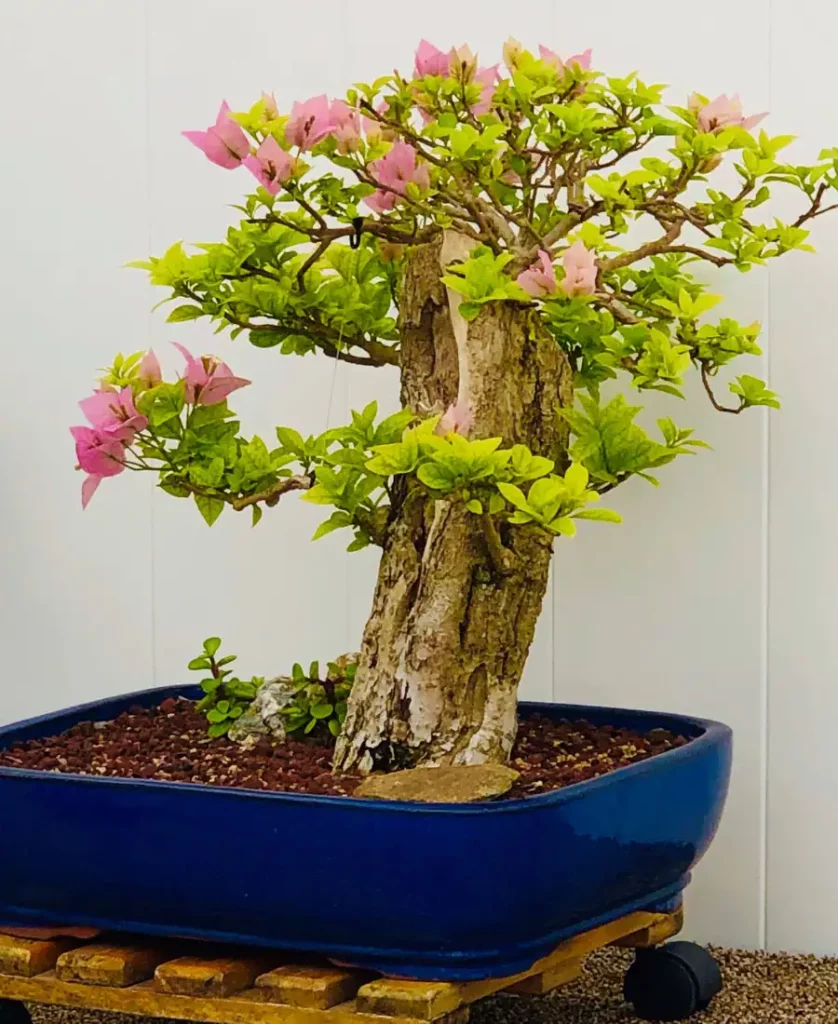
Bougainvillea is a fast-growing plant. Depending on the species, this plant will grow 36-48 inches (3-4 feet) every year.
If your bougainvillea shows stunted growth, you likely have an overwatering or nutrient deficiency problem.
Common Problems with Bougainvillea
Bougainvillea has excellent resistance to pests and diseases but is still vulnerable to some infestations and infections.
Common pests affecting Bougainvillea include aphids, scale, spider mites, and whiteflies, while common Bougainvillea diseases include bacterial and fungal leaf spot. These can use the bougainvillea leaves to curl and deform.
Other problems common in bougainvillea include poor cold tolerance and root rot.
You can control most Bougainvillea pest and disease problems by introducing natural predators or applying chemical pesticides. However, pesticides should only be used as a last resort due to their negative environmental impacts.
Here are some signs that your bougainvillea is suffering from the above problems.
Sooty mold
If you notice your bougainvillea foliage is covered in a sooty substance, the plant is infested with aphids, scale, or whiteflies. You can control aphids and whiteflies by introducing natural predators like lacewing and ladybugs. Scale, meanwhile, can be easily scraped off the plant’s foliage. Alternatively, wipe the affected parts with isopropyl alcohol.
Leaf spot disease
Bougainvillea leaves with red or brown spots that gradually get larger and darker are a sign of bacterial or fungal leaf spot disease. Prune off infected foliage and limbs to prevent disease from spreading to unaffected plant parts.
Leaf drop
Bougainvillea is native to tropical regions where temperatures are warm. Therefore, it has poor cold tolerance. Consistently cold temperatures that drop below 65 degrees Fahrenheit at night will cause the plant’s leaves to fall off. Frost damage can be prevented by moving the plant indoors during winter.
Root rot
Bougainvillea is vulnerable to root rot if planted in slow-draining or overwatered soil. To avoid killing the plant, repot in well-draining soil.
FAQ
Is bougainvillea better in pots or ground?
Bougainvillea can be grown in both pots and the ground. Pots offer portability and control over soil conditions, ideal for colder climates or limited spaces. Ground planting suits larger spaces and provides more room for roots, allowing bougainvillea to reach its full potential.
Does a bougainvillea need a trellis?
Taller varieties of bougainvillea need support, otherwise, they’ll easily grow as groundcover plants. To elevate bougainvilleas, tie them to trellises, arbors, fences, or other useful structures. Without support, these twining vines turn groundward. Trellises can help to train the plant to grow in the desired direction. If there are heavy branches on the plant, use a trellis to provide the needed support and prevent breaking.
Conclusion
The best care routine for bougainvillea would be trying to match the plant’s near-native growing conditions. Deep watering, warm temperatures, adequate heat exposure, and occasional repotting will give you the best bougainvillea plants for your yard or garden.


